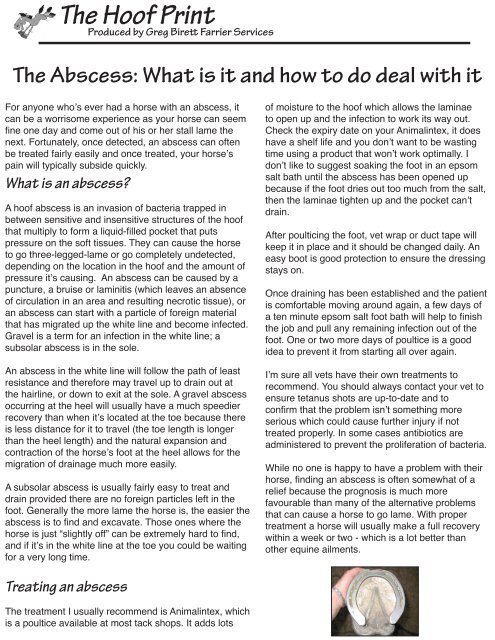You also want an ePaper? Increase the reach of your titles
YUMPU automatically turns print PDFs into web optimized ePapers that Google loves.
<strong>The</strong> <strong>Hoof</strong> <strong>Print</strong><br />
Produced by Greg Birett <strong>Farrier</strong> Services<br />
<strong>The</strong> Abscess: What is it and how to do deal with it<br />
For anyone who’s ever had a horse with an abscess, it<br />
can be a worrisome experience as your horse can seem<br />
fine one day and come out of his or her stall lame the<br />
next. Fortunately, once detected, an abscess can often<br />
be treated fairly easily and once treated, your horse’s<br />
pain will typically subside quickly.<br />
What is an abscess?<br />
A hoof abscess is an invasion of bacteria trapped in<br />
between sensitive and insensitive structures of the hoof<br />
that multiply to form a liquid-filled pocket that puts<br />
pressure on the soft tissues. <strong>The</strong>y can cause the horse<br />
to go three-legged-lame or go completely undetected,<br />
depending on the location in the hoof and the amount of<br />
pressure it’s causing. An abscess can be caused by a<br />
puncture, a bruise or laminitis (which leaves an absence<br />
of circulation in an area and resulting necrotic tissue), or<br />
an abscess can start with a particle of foreign material<br />
that has migrated up the white line and become infected.<br />
Gravel is a term for an infection in the white line; a<br />
subsolar abscess is in the sole.<br />
An abscess in the white line will follow the path of least<br />
resistance and therefore may travel up to drain out at<br />
the hairline, or down to exit at the sole. A gravel abscess<br />
occurring at the heel will usually have a much speedier<br />
recovery than when it’s located at the toe because there<br />
is less distance for it to travel (the toe length is longer<br />
than the heel length) and the natural expansion and<br />
contraction of the horse’s foot at the heel allows for the<br />
migration of drainage much more easily.<br />
A subsolar abscess is usually fairly easy to treat and<br />
drain provided there are no foreign particles left in the<br />
foot. Generally the more lame the horse is, the easier the<br />
abscess is to find and excavate. Those ones where the<br />
horse is just “slightly off” can be extremely hard to find,<br />
and if it’s in the white line at the toe you could be waiting<br />
for a very long time.<br />
Treating an abscess<br />
<strong>The</strong> treatment I usually recommend is Animalintex, which<br />
is a poultice available at most tack shops. It adds lots<br />
of moisture to the hoof which allows the laminae<br />
to open up and the infection to work its way out.<br />
Check the expiry date on your Animalintex, it does<br />
have a shelf life and you don’t want to be wasting<br />
time using a product that won’t work optimally. I<br />
don’t like to suggest soaking the foot in an epsom<br />
salt bath until the abscess has been opened up<br />
because if the foot dries out too much from the salt,<br />
then the laminae tighten up and the pocket can’t<br />
drain.<br />
After poulticing the foot, vet wrap or duct tape will<br />
keep it in place and it should be changed daily. An<br />
easy boot is good protection to ensure the dressing<br />
stays on.<br />
once draining has been established and the patient<br />
is comfortable moving around again, a few days of<br />
a ten minute epsom salt foot bath will help to finish<br />
the job and pull any remaining infection out of the<br />
foot. one or two more days of poultice is a good<br />
idea to prevent it from starting all over again.<br />
I’m sure all vets have their own treatments to<br />
recommend. You should always contact your vet to<br />
ensure tetanus shots are up-to-date and to<br />
confirm that the problem isn’t something more<br />
serious which could cause further injury if not<br />
treated properly. In some cases antibiotics are<br />
administered to prevent the proliferation of bacteria.<br />
While no one is happy to have a problem with their<br />
horse, finding an abscess is often somewhat of a<br />
relief because the prognosis is much more<br />
favourable than many of the alternative problems<br />
that can cause a horse to go lame. With proper<br />
treatment a horse will usually make a full recovery<br />
within a week or two - which is a lot better than<br />
other equine ailments.


